Identification of Shrinkage and Growth Patterns of a Shrinking City in China Based on Nighttime Light Data: A Case Study of Yichun
Abstract
1. Introduction
2. Study Area and Background
3. Data Processing and Methods
3.1. Data Source
3.2. Data Pre-Processing
3.2.1. Extreme Value Processing
3.2.2. Extraction of NTL Images of Built-Up Areas
3.3. Method
3.3.1. Simple Linear Regression
3.3.2. Metric Method
4. Temporal and Spatial Patterns of Shrinkage and Growth in Yichun City
4.1. Overall Temporal and Spatial Pattern of Shrinkage snd Growth
4.1.1. Regional Differences in Urban Shrinkage
4.1.2. Partial Shrinkage
4.1.3. Changes in Regional Development Differences
4.2. Refined Recognition
4.2.1. Growth Area
4.2.2. Shrinking Areas
5. Discussion and Conclusions
5.1. Discussion
5.1.1. The Characteristics of Shrinkage
5.1.2. The Performance of NPP-VIIRS NTL Data
5.2. Conclusions
Author Contributions
Funding
Conflicts of Interest
References
- Häußermann, H.; Siebel, W. Die Schrumpfende Stadt und die Stadtsoziologie. In Soziologische Stadtforschung; Friedrich, J., Ed.; Westdeutscher Verlag: Opladen, Germany, 1988; pp. 78–94. [Google Scholar]
- Turok, I.; Mykhnenko, V. The trajectories of European cities, 1960–2005. Cities 2007, 24, 165–182. [Google Scholar] [CrossRef]
- Kabisch, N.; Haase, D.; Haase, A. Evolving reurbanisation? Spatio-temporal dynamics exemplified at the eastern German cityof Leipzig. Urban Stud. 2009, 47, 967–990. [Google Scholar] [CrossRef]
- Hospers, G. Coping with shrinkage in Europe’s cities and towns. Urban Des. Int. 2012, 18, 78–89. [Google Scholar] [CrossRef]
- Camarda, D.; Rotondo, F.; Selicato, F. Strategies for dealing with urban shrinkage: Issues and scenarios in Taranto. Eur. Plan. Stud. 2014, 23, 126–146. [Google Scholar] [CrossRef]
- Haase, D.; Haase, A.; Rink, D. Conceptualizing the nexus between urban shrinkage and ecosystem services. Landsc. Urban Plan. 2014, 132, 159–169. [Google Scholar] [CrossRef]
- Mallach, A.; Haase, A.; Hattori, K. The shrinking city in comparative perspective: Contrasting dynamics and responses to urban shrinkage. Cities 2017, 69, 102–108. [Google Scholar] [CrossRef]
- Joo, Y.; Seo, B. Dual policy to fight urban shrinkage: Daegu, South Korea. Cities 2018, 73, 128–137. [Google Scholar] [CrossRef]
- Pallagst, K. Shrinking cities-planning challenges from an international perspective. In Cities Growing Smaller, Urban Infill 1; Cleveland Urban Design Collabo: Cleveland, OH, USA, 2008; pp. 6–16. [Google Scholar]
- Wiechmann, T.; Pallagst, K.M. Urban shrinkage in Germany and the USA: A comparison of transformation patterns and local strategies. Int. J. Urban Reg. Res. 2012, 36, 261–280. [Google Scholar] [CrossRef]
- Blanco, H.; Alberti, M.; Forsyth, A.; Krizekc, K.J.; Rodríguezd, D.A.; Talene, E.; Ellisf, C. Hot, congested, crowded and diverse: Emerging research agendas in planning. Prog. Plan. 2009, 71, 153–205. [Google Scholar] [CrossRef]
- Wiechmann, T. Errors Expected—Aligning Urban Strategy with Demographic Uncertainty in Shrinking Cities. Int. Plan. Stud. 2008, 13, 431–446. [Google Scholar] [CrossRef]
- Pallagst, K.M.; Schwarz, T.; Popper, F.J.; Hollander, J.B. Planning shrinking cities. Prog. Plan. 2009, 72, 223–232. [Google Scholar]
- Schetke, S.; Haase, D. Multi-criteria assessment of socio-environmental aspects in shrinking cities. Experiences from eastern Germany. Environ. Impact Assess. Rev. 2008, 28, 483–503. [Google Scholar] [CrossRef]
- Martinez-Fernandez, C.; Weyman, T.; Fol, S.; Audirac, I.; Cunningham-Sabot, E.; Wiechmann, T.; Yahagi, H. Shrinking cities in Australia, Japan, Europe and the USA: From a global process to local policy responses. Prog. Plan. 2015, 105, 1–48. [Google Scholar] [CrossRef]
- Wu, K.; Long, Y.; Yang, Y. Urban shrinkage in the Beijing-Tianjin-Hebei Region and Yangtze River Delta: Pattern, trajectory and factors. Mod. Urban Res. 2015, 30, 26–35. [Google Scholar]
- Li, X.; Wu, K.; Long, Y.; Li, Z.; Luo, X.; Zhang, X.; Wang, D.; Yang, D.; Gui, Y.; Li, Y.; et al. Academic debates upon shrinking cities in China for sustainable development. Geogr. Res. 2017, 36, 1997–2016. [Google Scholar]
- Olsen, A.K. Shrinking cities: Fuzzy concept or useful framework? Berkeley Plan. J. 2013, 26, 105–132. [Google Scholar] [CrossRef]
- Oswalt, P.; Rieniets, T. Atlas of Shrinking Cities; Hatje Cantz: Ostfildern, Germany, 2006. [Google Scholar]
- Long, Y.; Wu, K.; Wang, J.H. Shrinking cities in China. Mod. Urban Res. 2015, 9, 14–19. (In Chinese) [Google Scholar]
- Alvesa, D.; Barreira, A.P.; Guimarães, M.H.; Panagopoulos, T. Historical trajectories of currently shrinking Portuguese cities: A typology of urban shrinkage. Cities 2016, 52, 20–29. [Google Scholar] [CrossRef]
- Li, X.; Du, Z.W.; Li, X.F. The spatial distribution and mechanism of city shrinkage in the Pearl River Delta. Mod. Urban Res. 2015, 9, 36–43. (In Chinese) [Google Scholar]
- Hartt, M. How cities shrink: Complex pathways to population decline. Cities 2016. [Google Scholar] [CrossRef]
- Mykhnenko, V.; Turok, I. East European Cities—Patterns of Growth and Decline, 1960–2005. Int. Plan. Stud. 2008, 13, 311–342. [Google Scholar] [CrossRef]
- Li, X.; Xu, H.; Chen, X.; Li, C. Potential of NPP-VIIRS NTL Imagery for Modeling the Regional Economy of China. Remote Sens. 2013, 5, 3057–3081. [Google Scholar] [CrossRef]
- Ma, T. Spatiotemporal characteristics of urbanization in china from the perspective of remotely sensed big data of nighttime light. J. Geo-Inf. Sci. 2019, 21, 59–67. [Google Scholar] [CrossRef]
- Liu, F.B.; Zhu, X.G.; Chen, J.; Sun, J.; Lin, X.Q. The research on the quantitative identification and cause analysis of urban shrinkage from different dimensions and scales: A case study of northeast China during transformation period. Mod. Urban Res. 2018, 37–46. (In Chinese) [Google Scholar] [CrossRef]
- Du, Z.W.; Li, X. Growth or shrinkage: New phenomena of regional development in the rapidly-urbanising Pearl River Delta. Acta Geogr. Sin. 2017, 72, 1800–1811. (In Chinese) [Google Scholar]
- Li, X.; Li, X.; Deng, J. The Growth and Shrinkage of China’s Rapidly Urbanizing Areas from the Perspective of Property Rights: A Case Study of Dongguan. Trop. Geogr. 2019, 39, 1–10. (In Chinese) [Google Scholar]
- Propastin, P.; Kappas, M. Assessing Satellite-Observed Nighttime Lights for Monitoring Socioeconomic Parameters in the Republic of Kazakhstan. GISci. Remote Sens. 2012, 49, 538–557. [Google Scholar] [CrossRef]
- Forbes, D.J. Multi-scale analysis of the relationship between economic statistics and DMSP-OLS night light images. Mapp. Sci. Remote Sens. 2013, 50, 483–499. [Google Scholar] [CrossRef]
- Henderson, J.V.; Storeygard, A.; Weil, D.N. Measuring Economic Growth from Outer Space. In National Bureau of Economic Research Working Paper; NBER: Cambridge, MA, USA, 2009. [Google Scholar]
- Doll, C.N.H.; Muller, J.-P.; Morley, J.G. Mapping regional economic activity from night-time light satellite imagery. Ecol. Econ. 2006, 57, 75–92. [Google Scholar] [CrossRef]
- Zhuo, L.; Chen, J.; Shi, P.J.; Gu, Z.H.; Fan, Y.D.; Ichinose, T. Modeling population density of China in 1998 based on DMSP/OLS nighttime light image. Acta Geogr. Sin. 2005, 60, 266–276. (In Chinese) [Google Scholar]
- Sutton, P.C.; Roberts, D.A.; Elvidge, C.D.; Melj, H. A Comparison of Nighttime Satellite Imagery and Population Density for the Continental United States. Am. Soc. Photogramm. Remote Sens. 1997, 63, 1303–1313. [Google Scholar]
- Shi, K.; Yu, B.; Huang, Y.; Hu, Y.; Yin, B.; Chen, Z.; Chen, L.; Wu, J. Evaluating the Ability of NPP-VIIRS NTL Data to Estimate the Gross Domestic Product and the Electric Power Consumption of China at Multiple Scales: A Comparison with DMSP-OLS Data. Remote Sens. 2014, 6, 1705–1724. [Google Scholar] [CrossRef]
- Min, B.; Gaba, K.M.; Sarr, O.F.; Agalassou, A. Detection of rural electrification in Africa using DMSP-OLS night lights imagery. Int. J. Remote Sens. 2013, 34, 8118–8141. [Google Scholar] [CrossRef]
- Cao, X.; Chen, J.; Imura, H.; Higashi, O. A SVM-based method to extract urban areas from DMSP-OLS and SPOT VGT data. Remote Sens. Environ. 2009, 113, 2205–2209. [Google Scholar] [CrossRef]
- Shi, K.; Chang, H.; Yu, B.; Yin, B.; Huang, Y.; Wu, J. Evaluation of NPP-VIIRS night-time light composite data for extracting built-up urban areas. Remote Sens. Lett. 2014, 5, 358–366. [Google Scholar] [CrossRef]
- Bennett, M.M.; Smith, L.C. Advances in using multitemporal night-time lights satellite imagery to detect, estimate, and monitor socioeconomic dynamics. Remote Sens. Environ. 2017, 192, 176–197. [Google Scholar] [CrossRef]
- Imhoff, M.L.; Lawrence, W.T.; Stutzer, D.C.; Elvidge, C.D. A technique for using composite DMSP/OLS “city lights” satellite data to map urban area. Remote Sens. Environ. 1997, 61, 361–370. [Google Scholar] [CrossRef]
- Small, C.; Elvidge, C.D.; Balk, D.; Montgomery, M. Spatial Scaling of Stable Night Lights. Remote Sens. Environ. 2011, 115, 269–280. [Google Scholar] [CrossRef]
- Small, C.; Pozzi, F.; Elvidge, C.D. Spatial Analysis of Global Urban Extent from DMSP-OLS Night Lights. Remote Sens. Environ. 2005, 96, 277–291. [Google Scholar] [CrossRef]
- Shen, Z.; Zhu, X.; Cao, X.; Chen, J. Measurement of blooming effect of DMSP-OLS NTL data based on NPP-VIIRS data. Ann. GIS 2019, 25, 153–165. [Google Scholar] [CrossRef]
- Hillger, D.; Kopp, T.; Lee, T.; Lindsey, D.; Seaman, C.; Miller, S.; Solbrig, J.; Kidder, S.; Bachmeier, S.; Jasmin, T.; et al. First Light Imagery from Suomi NPP VIIRS. Bull. Am. Meteorol. Soc. 2013, 94, 1019–1029. [Google Scholar] [CrossRef]
- Xie, Y.; Weng, Q.; Weng, A. A comparative study of NPP-VIIRS and DMSP-OLS nighttime light imagery for derivation of urban demographic metrics. In Proceedings of the 2014 Third International Workshop on Earth Observation and Remote Sensing Applications (EORSA), Changsha, China, 11–14 June 2014. [Google Scholar] [CrossRef]
- Ma, T.; Zhou, C.; Pei, T.; Haynie, S.; Fan, J. Responses of Suomi-NPP VIIRS-derived NTLs to socioeconomic activity in China’s cities. Remote Sens. Lett. 2014, 5, 165–174. [Google Scholar] [CrossRef]
- Chen, X.; Nordhaus, W.D. VIIRS Nighttime Lights in the Estimation of Cross-Sectional and Time-Series GDP. Remote Sens. 2019, 11, 1057. [Google Scholar] [CrossRef]
- Yu, B.; Tang, M.; Wu, Q.; Yang, C.; Deng, S.; Shi, K.; Peng, C.; Wu, J.; Chen, Z. Urban Built-Up Area Extraction from Log-Transformed NPP-VIIRS Nighttime Light Composite Data. IEEE Geosci. Remote Sens. Lett. 2018, 15, 1279–1283. [Google Scholar] [CrossRef]
- Milesi, C. Mapping Urban Expansion Across North America Using Multi-Temporal Landsat and Nighttime Lights Data AGU Fall Meeting. In Proceedings of the AGU Fall Meeting Abstracts, San Francisco, CA, USA, 15–19 December 2014. [Google Scholar]
- Zhao, G.H.; Zhang, Q.L. Spatial distribution of population data based on nighttime light and LUC data in the Sichuan-Chongqing Region. J. Geo-Inf. Sci. 2018, 20, 68–78. (In Chinese) [Google Scholar]
- Peiyong, D.; Yihua, L. Spatial Pattern and Influence Factors Analysis of Population Shrinkage in County Unit in China. Mod. Urban Res. 2018. (In Chinese) [Google Scholar]
- Zhang, X.L.; Liu, Y.B.; Lu, C.C. The background, identification of shrinking cities in China and their. J. Southeast Univ. (Philos. Soc. Sci.) 2016, 139. (In Chinese) [Google Scholar]
- Zhao, N.; Hsu, F.-C.; Cao, G.; Samson, E.L. Improving accuracy of economic estimations with VIIRS DNB image products. Int. J. Remote Sens. 2017, 38, 5899–5918. [Google Scholar] [CrossRef]
- Qiu, S.; Shao, X.; Cao, C.Y.; Uprety, S.; Wang, W.H. Assessment of straylight correction performance for the VIIRS day/night band using Dome-C and Greenland under lunar illumination. Int. J. Remote Sens. 2017, 38, 5880–5898. [Google Scholar] [CrossRef]
- Román, M.O.; Wang, Z.; Sun, Q.; Kalb, V.; Miller, S.D.; Molthan, A.; Schultz, L.; Bell, J.; Stokes, E.C.; Pandey, B.; et al. NASA’s Black Marble nighttime lights product suite. Remote Sens. Environ. 2018, 210, 113–143. [Google Scholar] [CrossRef]
- Lee, T.E.; Miller, S.D.; Turk, F.J.; Schueler, C.; Julian, R.; Deyo, S.; Dills, P.; Wang, S. The NPOESS VIIRS Day/Night Visible Sensor. Bull. Am. Meteorol. Soc. 2006, 87, 191–199. [Google Scholar] [CrossRef]


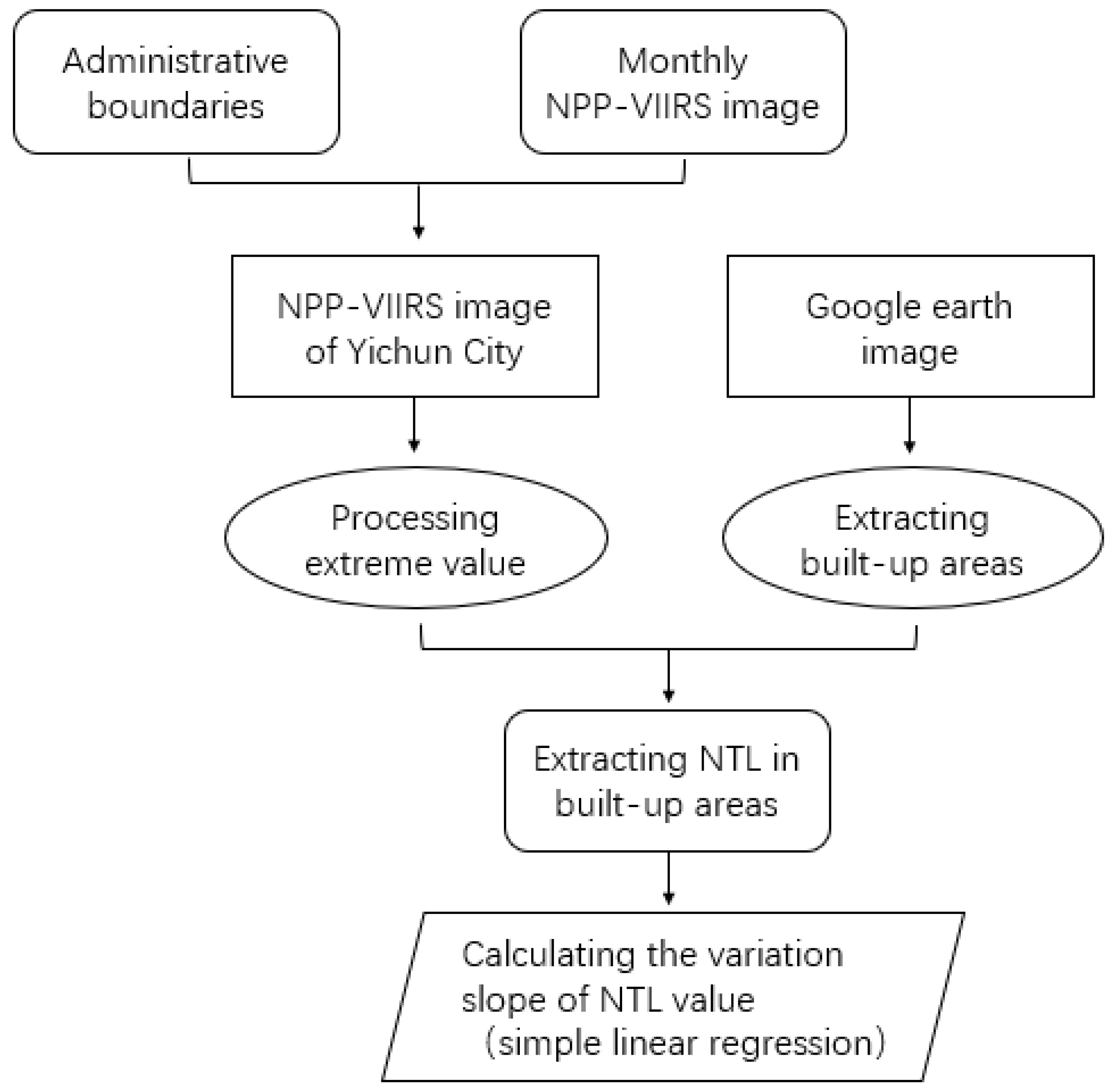
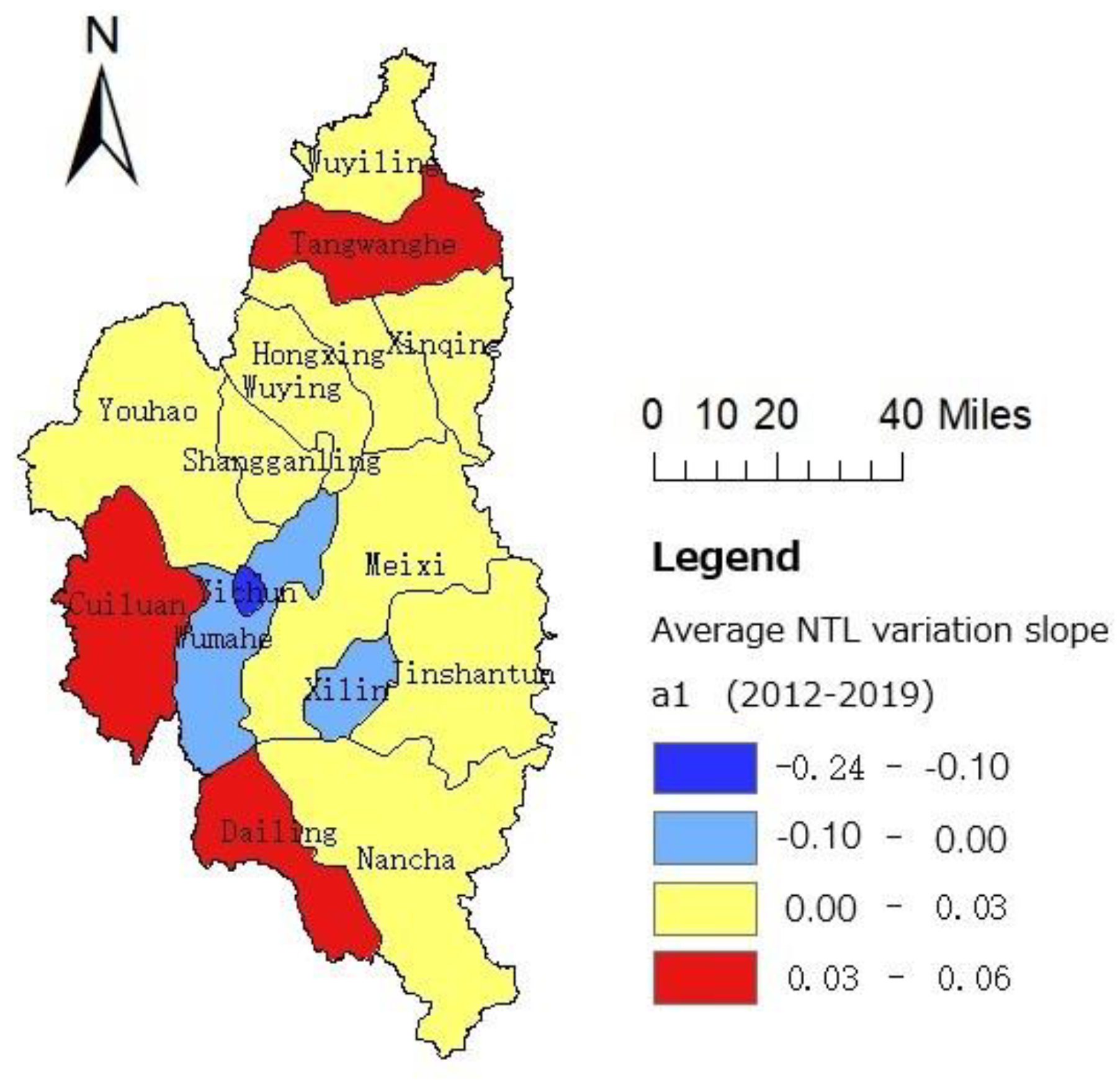
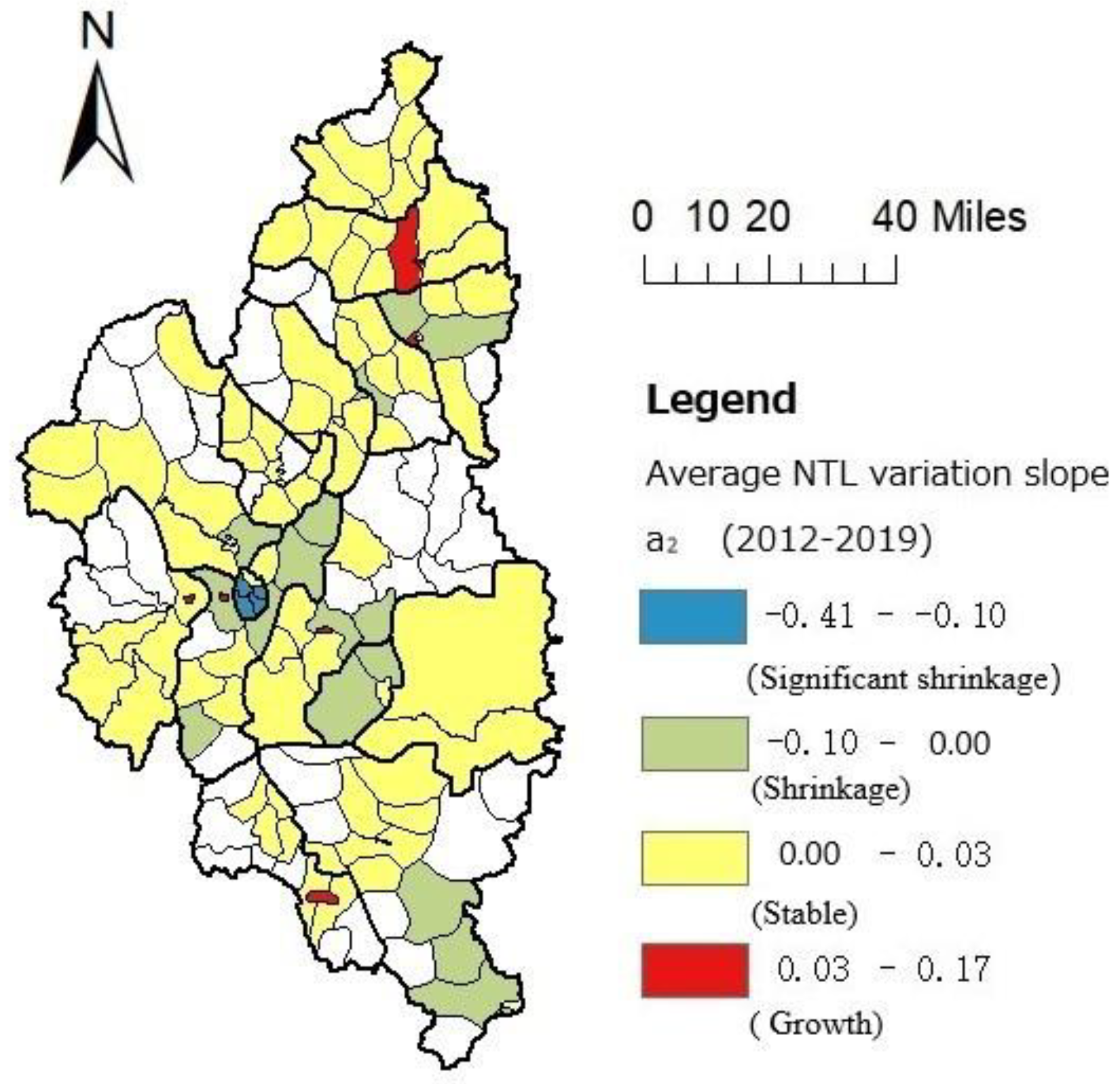
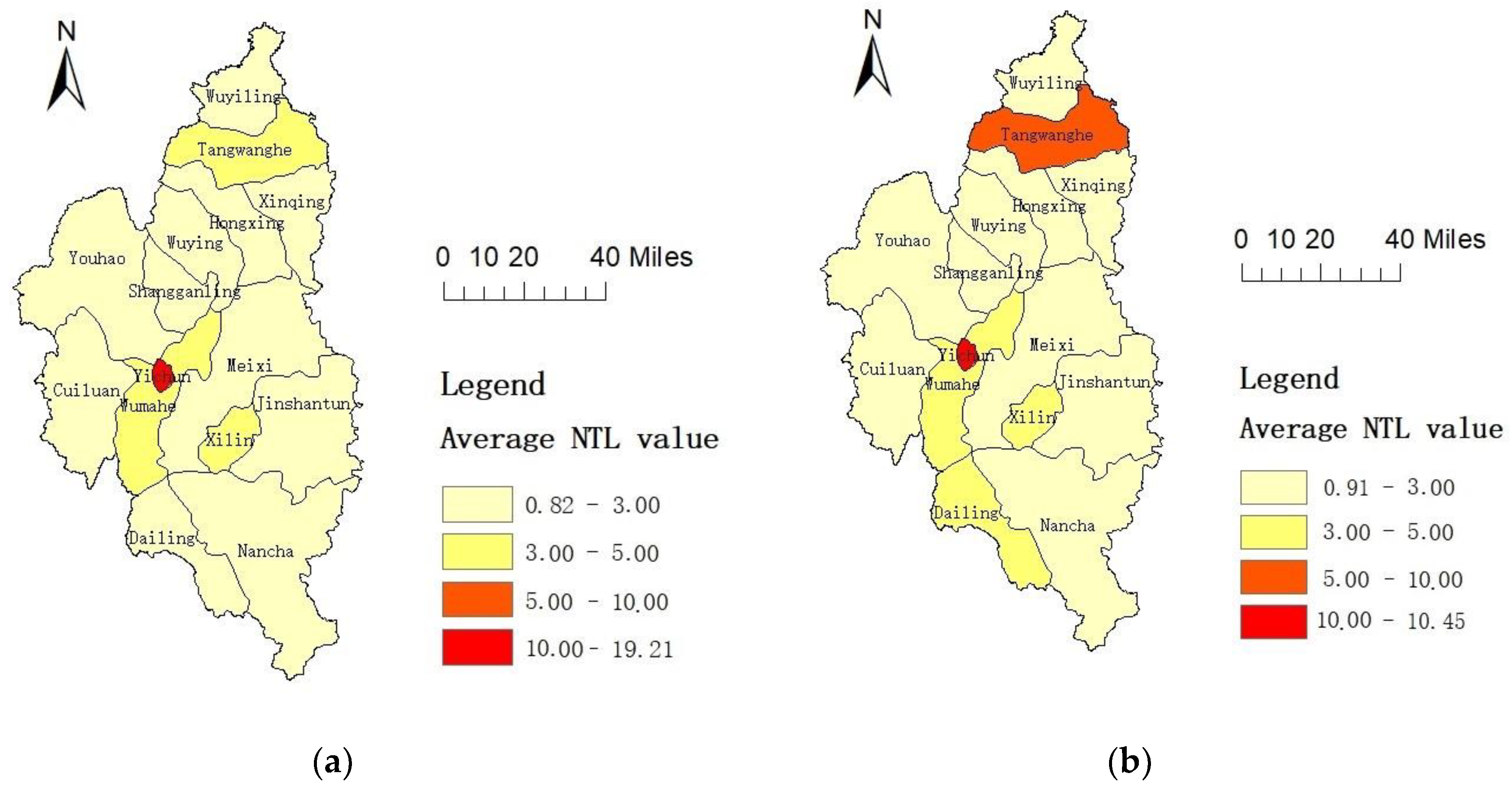
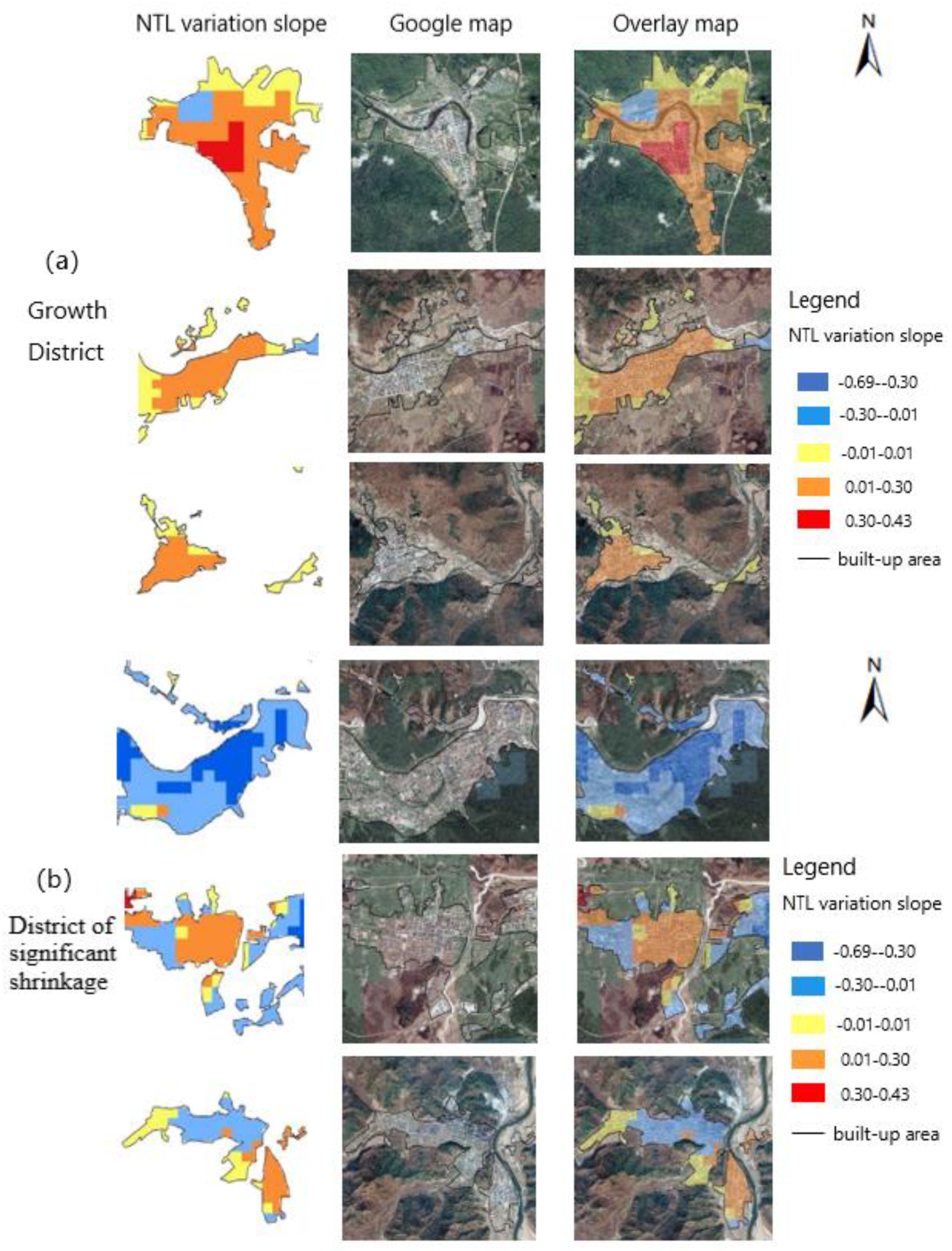
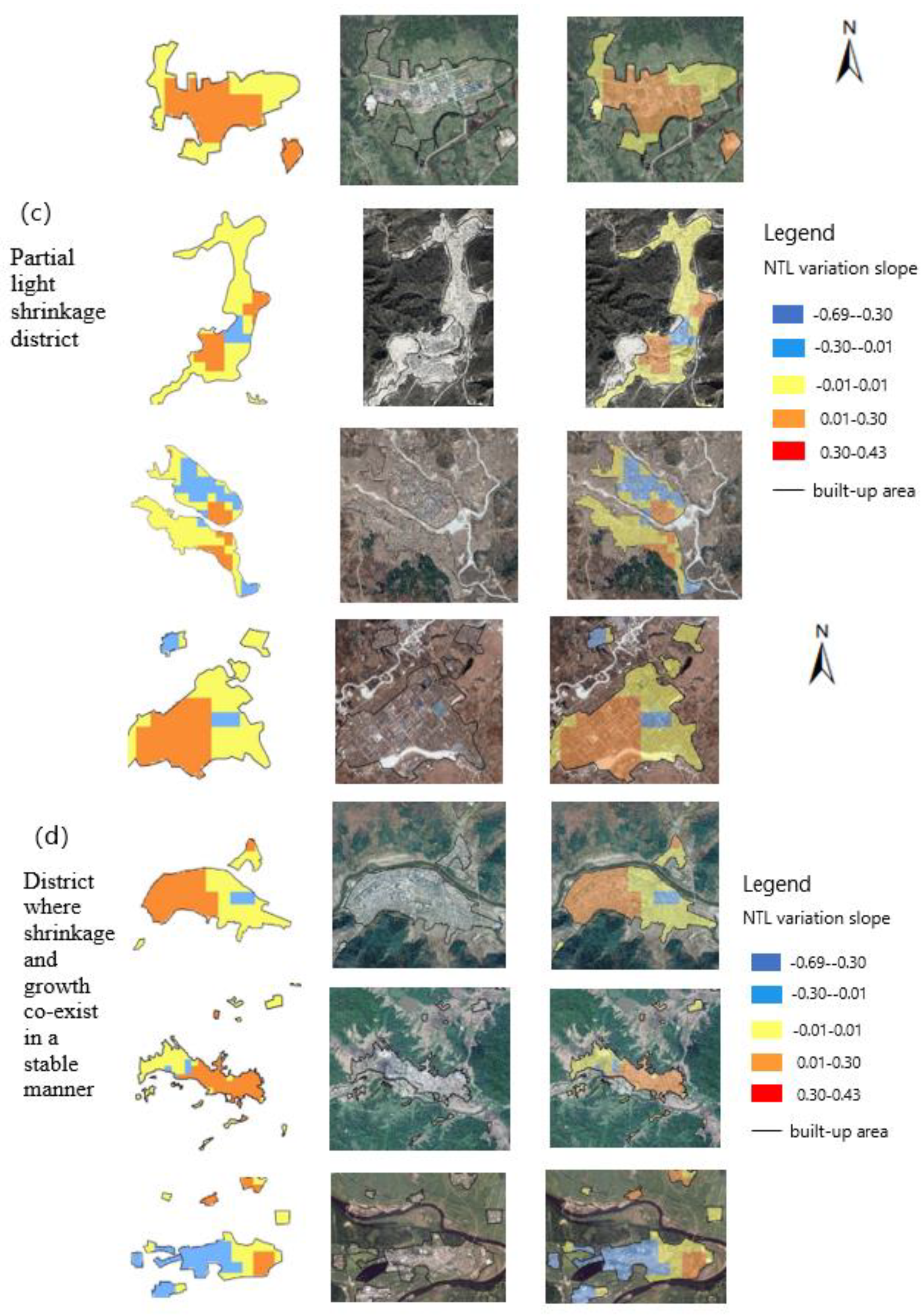
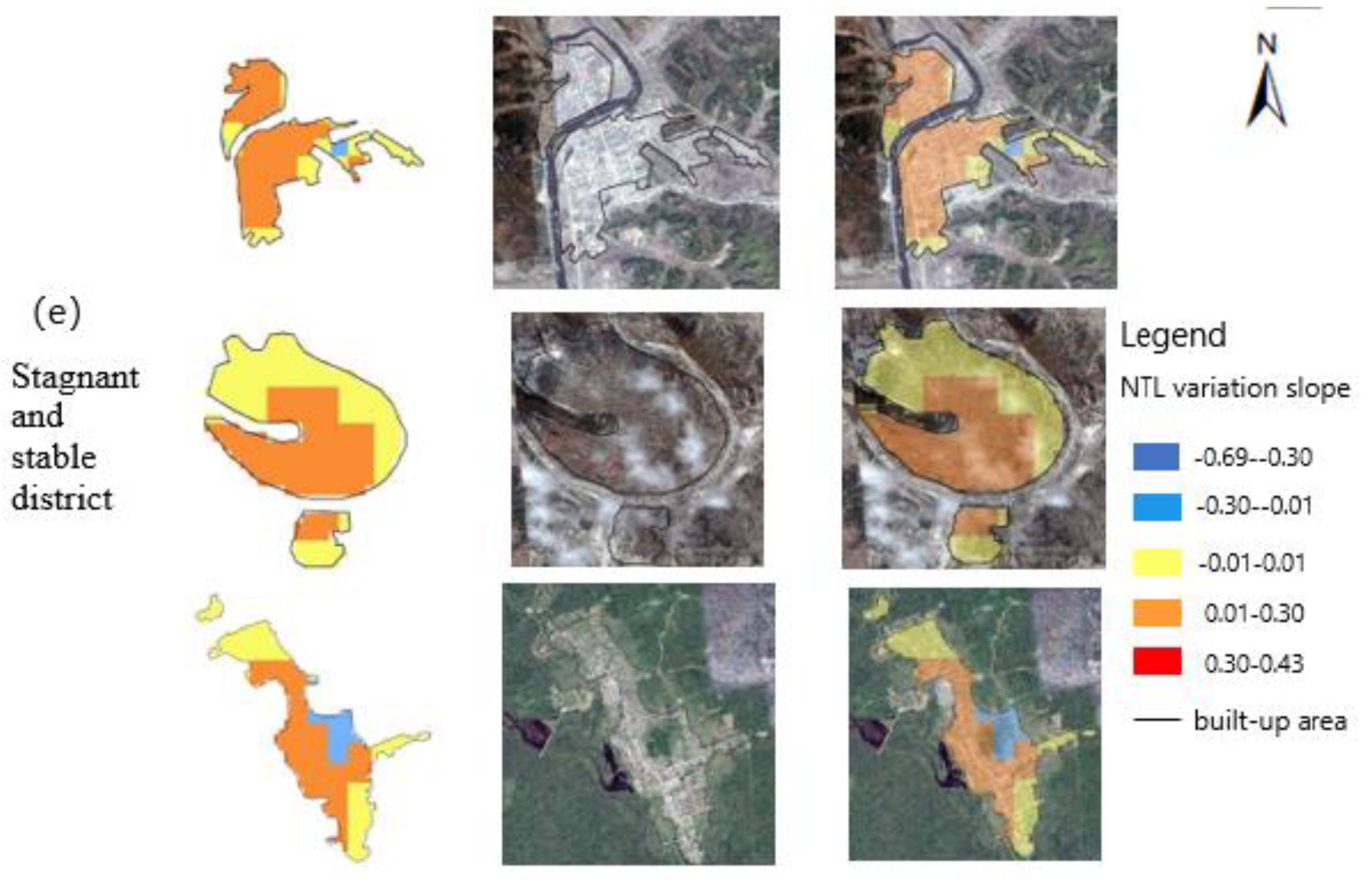
| Type | Criteria | Feature Description | |
|---|---|---|---|
| District Level(a1) | Sub-District Level(a2) | ||
| Growth district | a1 ≥ 0.03 | Average slope of NTL radiance value in the district is increasing | |
| Stagnant and Stable district | 0 ≤ a1 < 0.03 | 0 ≤ a2 < 0.03 | Average slope of NTL radiance value in the district and sub-district is stable |
| District where shrinkage and growth co-exist in a stable manner | ∃ a2 ≥ 0.03 and a2 < 0 | Average slope of NTL radiance value in the district is stable, internal growth and shrinkage co-exist | |
| Partial light shrinkage district | ∃ a2 < 0 | Average slope of NTL radiance value in the district is stable, there exists partial shrinkage but no growth | |
| District of significant shrinkage | a1 < 0 | Average slope of NTL radiance value in the district is shrinking | |
| Shrinkage Distribution | District | Driving Factors |
|---|---|---|
| Core block | Yichun District, Wuying District | 1. Short housing supply 2. Low birth rate/migration 3. Service industry decline |
| Forest farm | Xinqing District, Meixi District, Youhao District, Hongxing District | 1. Policy ban on logging 2. Withdrawal and merging of forest farms and ecological migration |
| Old industrial area | Xilin District | 1. Diminished excess industrial capacities/reforms 2. Economic decline of sectors/jobs |
| Secondary block | Nancha District, Wumahe district | 1. Economic decline of sectors/jobs 2. Low birth rate/migration |
© 2019 by the authors. Licensee MDPI, Basel, Switzerland. This article is an open access article distributed under the terms and conditions of the Creative Commons Attribution (CC BY) license (http://creativecommons.org/licenses/by/4.0/).
Share and Cite
Zhou, Y.; Li, C.; Ma, Z.; Hu, S.; Zhang, J.; Liu, W. Identification of Shrinkage and Growth Patterns of a Shrinking City in China Based on Nighttime Light Data: A Case Study of Yichun. Sustainability 2019, 11, 6906. https://doi.org/10.3390/su11246906
Zhou Y, Li C, Ma Z, Hu S, Zhang J, Liu W. Identification of Shrinkage and Growth Patterns of a Shrinking City in China Based on Nighttime Light Data: A Case Study of Yichun. Sustainability. 2019; 11(24):6906. https://doi.org/10.3390/su11246906
Chicago/Turabian StyleZhou, Ying, Chenggu Li, Zuopeng Ma, Shuju Hu, Jing Zhang, and Wei Liu. 2019. "Identification of Shrinkage and Growth Patterns of a Shrinking City in China Based on Nighttime Light Data: A Case Study of Yichun" Sustainability 11, no. 24: 6906. https://doi.org/10.3390/su11246906
APA StyleZhou, Y., Li, C., Ma, Z., Hu, S., Zhang, J., & Liu, W. (2019). Identification of Shrinkage and Growth Patterns of a Shrinking City in China Based on Nighttime Light Data: A Case Study of Yichun. Sustainability, 11(24), 6906. https://doi.org/10.3390/su11246906





